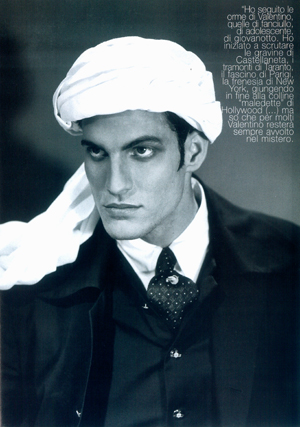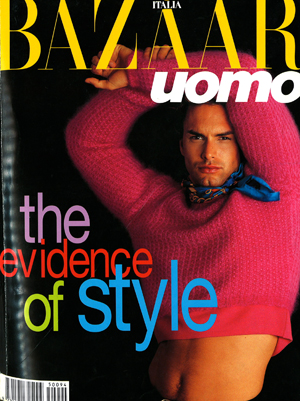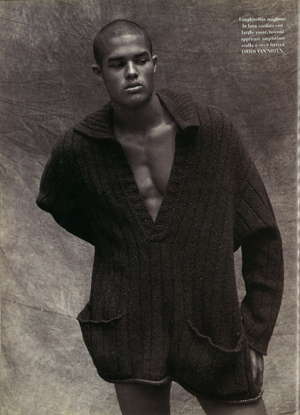HARPER’S BAZAAR UOMO 1997
Fashion shooting inspired by Rodolfo Valentino. The fashion of that season was perfectly close to 20’s. Ph. Davide Cernuschi, total look Vivienne Westwood.

Fashion shooting inspired by Rodolfo Valentino. The fashion of that season was perfectly close to 20’s. Ph. Davide Cernuschi, total look Vivienne Westwood.

Every passing decade leaves different shapes of clothes behind. In the past I already wroteabout the beauty of knowing how to mix and matchvintage with modern pieces, even suggesting fabrics and trends that we haven’t seen in a while. Of course, there’s always something that cannot be proposed ever again, like the Varty and Cleaver’s typical nuance of white (the couple of designers who has made Byblos glorious in the 80s), that was their signature sign; in an ideal world, where we would have the chanceand the space to preserve our clothes in perfect conditions, one should never get rid of their pieces!The latest kaleidoscopic fashion shows are pushing the bouderies, in favour of creativity. A great example of repechage would be ashirt in a very light and soft corduroy fabric with a smooth velvet tie, so that their rubbing against eachother wont reduce the natural movement of fabrics. Since velvet is quite a thick material, the jacket to wear should be made in a lighter fabric as a consequence. Perhaps a wool crepe or a silk and wool blend one. And maybe who knows… even the white ankle lenght longcoat could always make its comeback..
Image by Davide Cernuschi, from a 1997 Harper’s Bazaar Uomo issue. Woolen suit, velvet shirt and tie by Giorgio Armani.
Prima sfilata di Tom Ford per Gucci, presentata a Firenze. Il designer si impose con una collezione controcorrente. In tempo di minimalismo e total black propose colori violenti, anche negli accessori, riprendendo materiali come il mohair, più vicini all’abbigliamento femminile. Nella foto il top model svedese Marcus Schenkenberg sulla cover di Harper’s Bazaar Uomo del luglio 1995, fotografato da Judson Baker.

First fashion show of the collection of Gucci designed by Tom Ford, presented in Florence. The designer came out with an upstream collection. In time of minimalism and total black, he suggested violent colors, even for the accessories, recovering materials such as mohair, closer to womenswear. In the photo the Swedish supermodel Marcus Schenkenberg on the cover of Harper’s Bazaar Men of July 1995, photographed by Judson Baker.
“Who is ever going to wear that?”. Now more than ever the most popular comment between non-fashion insiders, because today we see a lot of people wearing “that”. Some excesses aren’t strictly catwolk-related anymore, why? Because the system is deeply changed: today a good half of the brands, is gaining profit from the self-portraits of tons of fashion addicts with their favorite designer’s pieces on and sharing them on the social networks. That’s it, through this media the picture can reach millions of people in half a second.It doesn’t even matter if the sobject actually do know anything about fashion or not, the value of the picture resides in two main features: beauty (real or assumed), and contest: the most popular shots are being taken by others, because that is a plus. If , on top of that, the picture is being taken at the front row of a fashion show, party or similars it can get a huge amount of views. It’s useless to wander if all of this makes any sense, because this is how things work now. It’s just better to get used to it and try not to be too queasy: If certain attitudes and laughable poses help to boost sales, it’s all good. Waiting for better days.
Quando la maglia può sostituire addirittura il cappotto, come questo profondo V neck in lana cardata oversize creato da Dries Van Noten. Foto di Judson Baker tratta da Harper’s Bazaar Uomo numero di settembre 1993.

When the sweater can even replace the coat, as this deep oversize wool V neck created by Dries Van Noten. Photo by Judson Baker is from Harper’s Bazaar Uomo September issue, 1993.